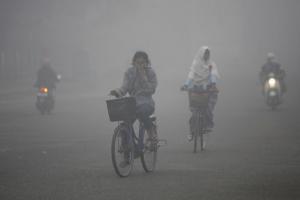Public healthSmoke from 2015 Indonesian fires may have caused more than 100,000 deaths
In the fall of 2015, hazardous levels of smoke from agricultural fires blanketed much of Equatorial Asia. Schools and businesses closed, planes were grounded, and tens of thousands sought medical treatment for respiratory illness. In a new study, researchers estimate that the 2015 smoke event caused upward of 100,000 deaths across Indonesia, Malaysia, and Singapore.

Borneo residents struggling with smoke from wildfires // Source: theconversation.com
In the fall of 2015, hazardous levels of smoke from agricultural fires blanketed much of Equatorial Asia. Schools and businesses closed, planes were grounded, and tens of thousands sought medical treatment for respiratory illness.
In a new study, Harvard University researchers and their colleagues estimate that the 2015 smoke event caused upwards of 100,000 deaths across Indonesia, Malaysia, and Singapore.
Harvard says that to mitigate the impact of future smoke events, the team developed a model framework which could help governments and policymakers in Southeast Asia identify, in almost real time, the fires with the highest potential to cause damage to human health.
The research is described in Environmental Research Letters . It was led by researchers from the Harvard John A. Paulson School of Engineering and Applied Sciences (SEAS), the Department of Earth and Planetary Sciences, and the T. H. Chan School of Public Health, in collaboration with colleagues from Columbia University.
“Although the regions experienced several major haze events over the past twenty years, the 2015 event was one of the worst,” said Shannon N. Koplitz, first author and Harvard graduate student. “We understand many of the underlying conditions that lead to these extreme events, and we can often predict when smoke pollution will be severe based on particular meteorological indicators, but regional efforts to mitigate the effects on public health have not been successful.”
“Our hope is that this framework can inform early-response efforts to identify areas where effective fire and land use management would yield the greatest benefits to human health, even as the haze event is still unfolding,” said Loretta J. Mickley, Senior Research Fellow at SEAS and coauthor.
The research is part of a larger effort by Harvard and Columbia to provide local stakeholders with an effective tool to assess the public health costs from fires and guide policy decisions. The framework uses a mathematical model to quickly identify the fires that will have the biggest impact on human health downwind.
“Decisions on how to manage the lands, which geographies to protect, how industries are regulated and where fires are allowed to burn are decisions of life and death,” said Samuel Myers, Senior Research Scientist at the T. H. Chan School of Public Health, Director of the Planetary Health Alliance and coauthor of the paper. “We want to support local policy makers to make those decisions with clear data.”
